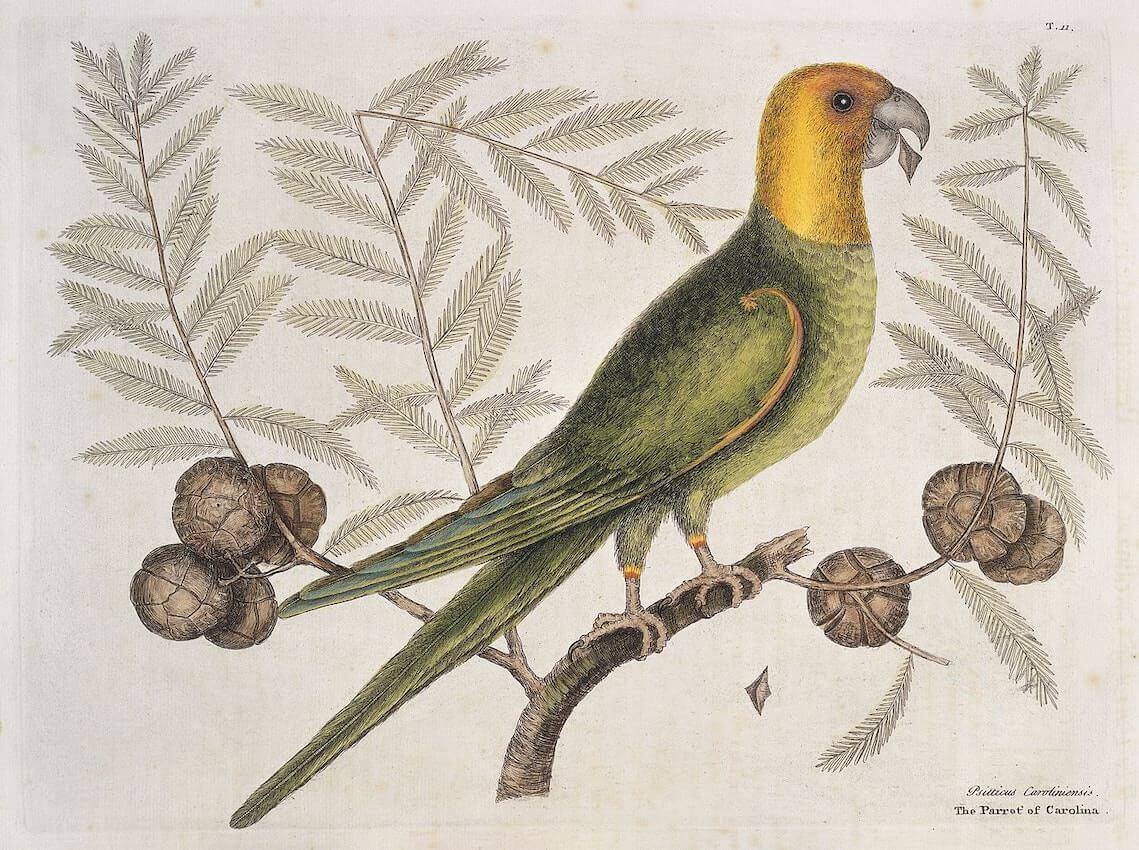Conuropsis carolinensis
1918
Illustration of a Carolina parakeet from Mark Catesby's The Natural History of Carolina, Florida and Bahamas (1754) -- Source

Conuropsis carolinensis
1918
Illustration of a Carolina parakeet from Mark Catesby's The Natural History of Carolina, Florida and Bahamas (1754) -- Source
The Carolina parakeet shares a bleak historical affinity with the passenger pigeon: the species were known to flock together, and four years after the death of Martha, the last passenger pigeon, Incas --- the final captive Carolina parakeet --- died in the same cage. This small green bird, with a lemon-yellow head and ruddy face, was the only indigenous parrot to the eastern Midwest and plains states, and one of only three parrots native to the United States. It was first recorded by the English merchant venturer George Peckham in his A True Report of the Late Discoveries of the Newfound Lands (1588). The birds are thought to have been poisonous, due to cats who succumbed shortly after preying upon the parrots. Their voices imbue numerous European colonial travelogues, for the sound of parrots' cries were inseparable from the soundscape of arrival in the New World: the birdcall of a genus that did not live in Europe. Edward McIlhenny, son of the Tabasco pepper sauce tycoon, attempted to imitate their call: "While on the wing they chatter and cry continually; this cry sounds like 'qui' with the rising inflection on the i; this is repeated several times, the last one being drawn out like 'qui-i-i-i'." Yet by the nineteenth century, travelers were already noting the mournful silence that signaled their decline. The cause of their extinction is multifold: deforestation, hunting, capture by the pet trade, and competition for nesting sites by introduced species. Known to flock to the site of dead and dying birds, opportunists would exploit this behavior for wholesale slaughter.

Bos primigenius
1627
Illustration of an aurochs from Siegmund von Herberstein's Rervm Moscoviticarvm commentarij Sigismundi (1556) Source
The Carolina parakeet shares a bleak historical affinity with the passenger pigeon: the species were known to flock together, and four years after the death of Martha, the last passenger pigeon, Incas --- the final captive Carolina parakeet --- died in the same cage. This small green bird, with a lemon-yellow head and ruddy face, was the only indigenous parrot to the eastern Midwest and plains states, and one of only three parrots native to the United States. It was first recorded by the English merchant venturer George Peckham in his A True Report of the Late Discoveries of the Newfound Lands (1588). The birds are thought to have been poisonous, due to cats who succumbed shortly after preying upon the parrots. Their voices imbue numerous European colonial travelogues, for the sound of parrots' cries were inseparable from the soundscape of arrival in the New World: the birdcall of a genus that did not live in Europe. Edward McIlhenny, son of the Tabasco pepper sauce tycoon, attempted to imitate their call: "While on the wing they chatter and cry continually; this cry sounds like 'qui' with the rising inflection on the i; this is repeated several times, the last one being drawn out like 'qui-i-i-i'." Yet by the nineteenth century, travelers were already noting the mournful silence that signaled their decline. The cause of their extinction is multifold: deforestation, hunting, capture by the pet trade, and competition for nesting sites by introduced species. Known to flock to the site of dead and dying birds, opportunists would exploit this behavior for wholesale slaughter.